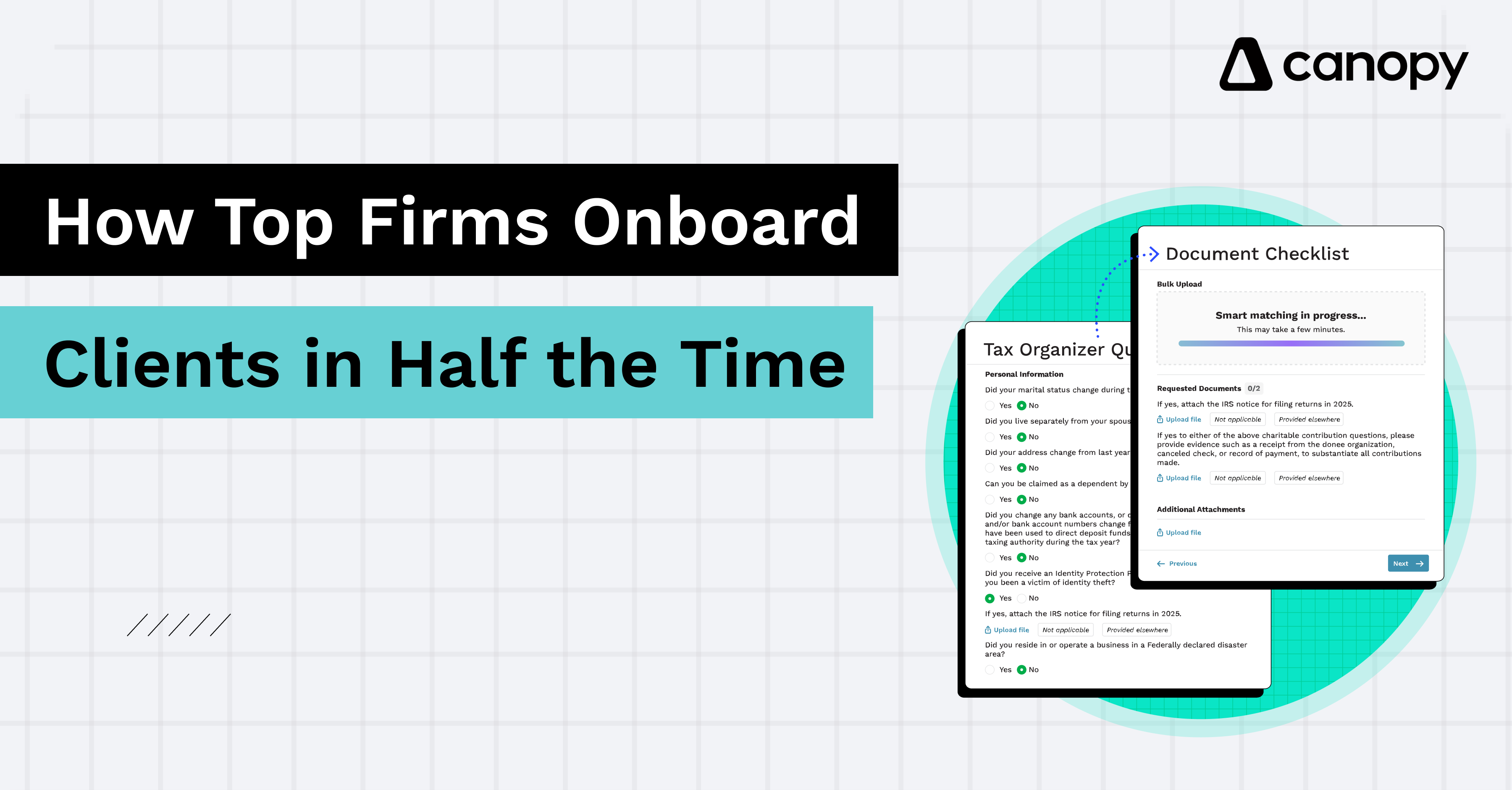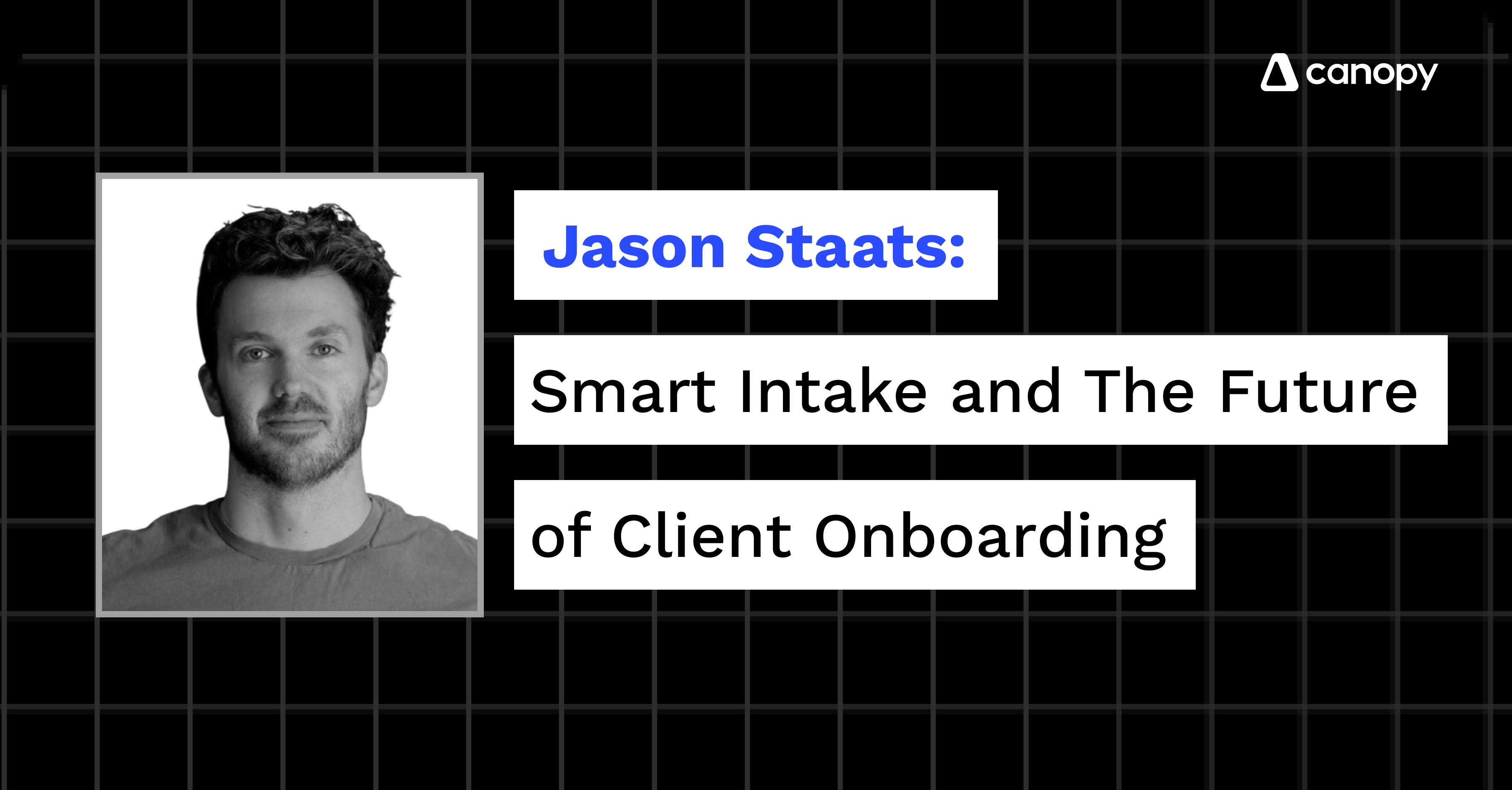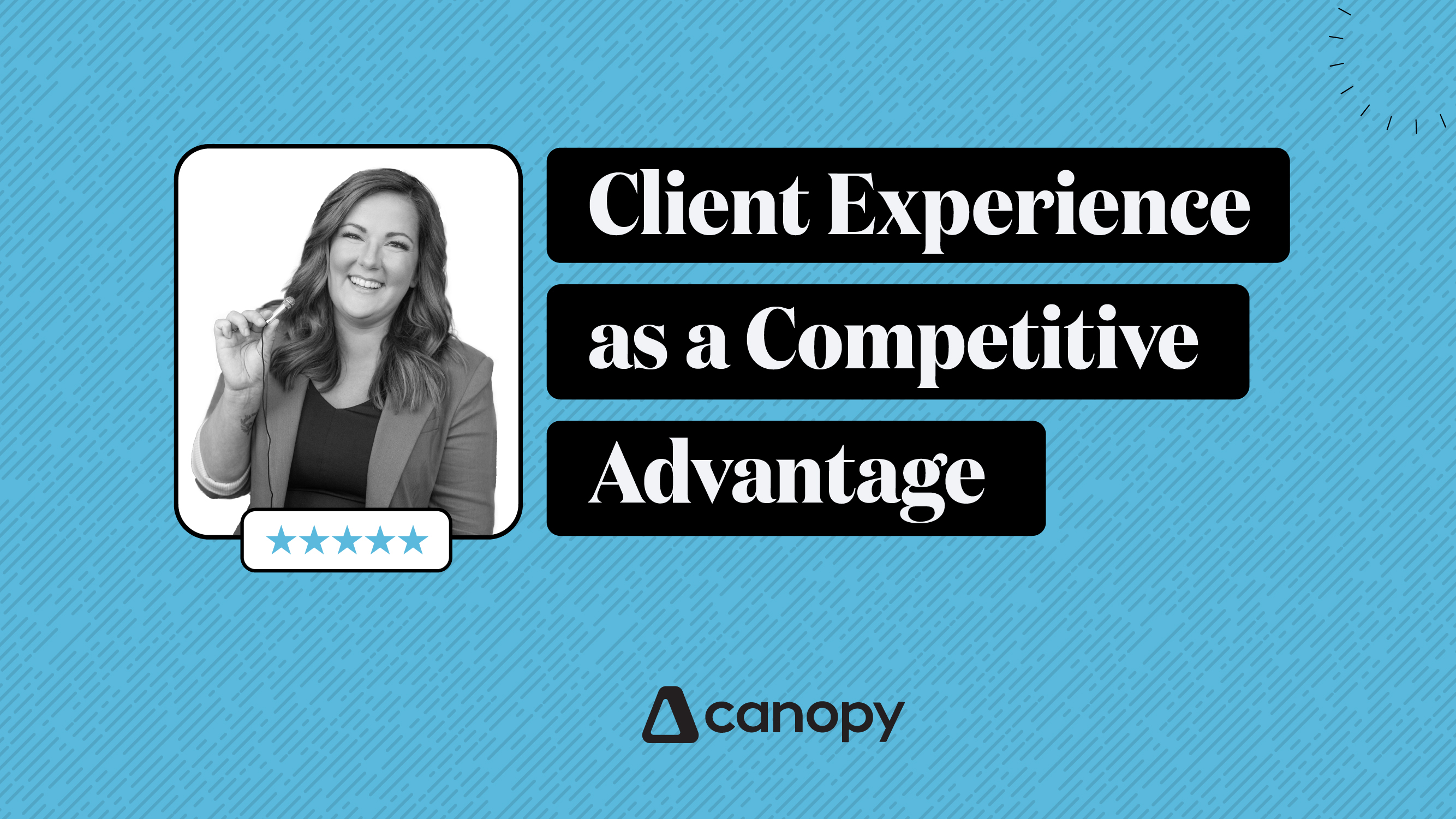AI has been quietly powering parts of your tech stack for years. But in 2025, it’s no longer just a behind-the-scenes helper.
With tools like GPT-4o, agent-based automation, and AI-powered practice management software, artificial intelligence is changing how accounting firms operate.
It’s helping teams:
- Save hours on manual admin tasks
- Communicate faster with clients
- Surface insights you used to spend hours digging for
The problem is that most firms don’t know where to start, and frankly, don’t have the time to figure it out.
This guide is your shortcut. Whether you’re skeptical or already experimenting, it’ll show you what’s possible (and what’s not) with AI in your firm.
We’ll cover:
- What AI in Accounting Looks Like in 2025
- Understanding Different Types of AI
- 8 Ways Accounting Firms Are Using AI in 2025
- What AI can’t do
- AI Features You Can Use in Canopy
- How Canopy Builds AI You Can Trust
- How to Start Using AI
What AI in Accounting Looks Like in 2025
Very few people are coding their own AI models in the back office. And unless your firm suddenly hired a machine learning team (which would be so cool), you’re not about to. The learning curve can be steep.
That’s fine. Because in 2025, you don’t have to.
Most of the AI that accounting firms use today is built right into their existing tools, whether it’s Canopy, Microsoft Copilot, or even your email platform. And when it’s done right, you probably don’t even notice it’s there.
Everyday Ways AI Shows Up in Accounting Workflows:
- Drafting client emails and follow-ups in seconds
- Auto-generating engagement letters
- Flagging missing documents or incomplete fields
- Catching errors based on historical data
- Summarizing long documents and complex tax law changes
- Turning messy internal notes into clean SOPs
It feels like magic, but it’s not. It’s just small, time-saving wins that add up, especially when you’re buried in deadlines or short on help.
Understanding Different Types of AI
AI shows up in accounting software in a few different ways. The two most common types are generative AI and agentic AI, and knowing the difference helps you understand what these tools can really do for your firm.
- Generative AI creates new content, like text, images, or code, based on a short prompt. It’s the technology behind tools like ChatGPT or Microsoft Copilot. These systems are trained on massive datasets and can draft emails, summarize documents, or generate creative ideas quickly.
- Large Language Models (LLMs) are a specific kind of generative AI. They’re designed to understand and produce human language. LLMs are what make it possible for AI to respond in full sentences, write professional messages, and understand nuanced prompts.
- Agentic AI doesn’t just generate content, it takes action. This type of AI can make decisions, follow goals, and complete tasks with minimal input. Agentic AI is built to operate more autonomously, whether it’s following up with a client or organizing a workflow.
- Machine Learning (ML) is a broader category that powers many types of AI. ML systems learn from data to recognize patterns and improve over time. You’ll see machine learning used for things like classifying documents, forecasting trends, or recommending next steps based on historical behavior.
8 Ways Accounting Firms Are Using AI in 2025
-
Automating client communication: Instead of typing the same message over and over, you can tell AI what you want to say, and it’ll write the first draft for you. Just review, make a few changes, and send.
-
Drafting proposals and engagement letters: Upload your firm’s templates, and AI can automatically insert client names, services, and deadlines, saving time and reducing errors.
-
Spotting anomalies in financial data: AI scans large datasets and flags anything that looks off, like duplicate transactions, missing fields, or inconsistencies across reports.
-
Helping with tax prep and compliance: Tools like Bluejay, TaxGPT, and CPA Copilot can break down IRS guidance into plain English, generate checklists, and track missing client documents to keep things on schedule.
-
Creating marketing content: Need a blog post, updated services page, or social media caption? Feed AI a prompt and get a solid starting point in seconds.
-
Simplifying SOPs and internal documentation: Instead of writing step-by-step guides from scratch, give AI your rough process or notes. It turns them into clean, structured team docs and can help you identify gaps.
-
Automating workflows with agentic AI: Agentic AI can take action on its own: pinging clients, updating your practice management system, or prepping documents without waiting on you. It’s like Zapier, but even better!
-
Supporting hiring and training: From onboarding a new admin to prepping for busy season, AI can help you build checklists, training guides, and quick-start documentation.
What AI Can’t Do
AI is powerful, but it’s far from perfect. It still needs your oversight, your judgment, and your understanding of nuance that no algorithm can replicate.
Here’s what AI can’t do in your firm:
- It doesn’t understand context like you do. It can miss nuance, tone, and the real meaning behind a client’s message.
- Get everything right. AI can generate incorrect or outdated information that sounds plausible, especially when it comes to taxes or compliance.
- Handle gray areas in compliance. AI isn’t built to handle edge cases, interpret vague guidance, or make judgment calls
- It’s not great at tailoring advice to a client’s unique situation. Each client’s situation is different, and AI can’t weigh business goals, personal preferences, or unspoken expectations the way you can.
- Think critically. AI doesn’t evaluate tradeoffs, push back when something doesn’t make sense, or spot when a client is asking the wrong question.
- Build relationships. AI doesn’t build trust, read the room, or nurture client loyalty. That still comes down to you and your team.
AI should help you move faster, reduce repetitive work, and free up your time. But it’s not the decision-maker. You are. Everything it creates still needs a human in the loop.
How Canopy is Helping Accounting Firms Embrace AI
Canopy isn’t here to give you flashy AI tools you’ll never use. We’re building practical, embedded AI tools that save you time and fit seamlessly into your existing workflow.
AI Features Available In Canopy:
- Smarter Document Management: AI can auto-tag, rename, and organize client files. It can even read scanned PDFs to pull out names, dates, and key details so nothing gets lost.
- Client Communication: AI can generate clean, professional emails or use smart replies to handle routine client questions in seconds. AI can also follow up automatically, ensuring clients respond (So you don’t have to chase them down!)
- Client Questionnaires: Canopy AI can auto-fill fields in client questionnaires using information from contact records, internal notes, and uploaded documents, saving time and reducing repetitive data entry.
- Smarter Task Handoffs: AI keeps context intact between assignments, reducing delays and errors during handoffs between team members.
- eSignatures: AI recommends field placements and templates to make sending documents for signature faster and more accurate.
- Built-In Business Insights: Get context-sensitive alerts and prioritization cues directly within your dashboard, so your team stays on top of deadlines and what matters most.
What’s coming by the end of 2025:
We’re continuing to push the boundaries of what’s possible with AI inside Canopy.
- AI-Powered Client Intake: Use last year’s data (documents or text entries) to create a custom Document Request List with any additional questions needed to capture other information.
- Workflow Assistants: AI will guide you through building or optimizing workflows, suggesting best practices, and highlighting potential improvements.
- Predictive Firm Analytics: Dive into the health of the firm and gain AI-driven insights to help improve profitability.
- Smarter Client Follow-Ups: Automatically send document requests and deadline nudges without lifting a finger.
- Centralized Communication Hub: Bring AI, client messages, tasks, and notes into a single, streamlined inbox for better team visibility and collaboration.
We know you want more freedom, which is why everything we’re building is designed to save you time, reduce errors, and make your team feel like they have a handle on everything.
Get a full breakdown of our 2025 AI product roadmap
How We Build AI You Can Trust
We’re all for letting the robots handle the busy work, but never at the expense of your privacy and control. That’s why every Canopy AI feature is built with your security and trust in mind. You stay in the driver’s seat, with full control over how your data is stored, accessed, and used.
Want the full breakdown? See our full AI Governance policy
How to Get Started Without the Burnout
You don’t need a big rollout plan to start using AI effectively. You just need to start.
Here’s how to experiment with AI without overwhelming your team or disrupting what’s already working:
- Start with one workflow. Choose a low-risk, repetitive task like drafting emails or creating engagement letters. Test how AI handles the first draft, then refine it from there.
- Use the tools you already have. Canopy, ChatGPT, and Microsoft Copilot can handle more than most firms realize. Before investing in something new, explore the AI features already built into your tech stack.
- Refine your prompts. The quality of your output depends on how you ask. Tweak the language until it reflects your firm’s tone and standards. Once you find what works, save your best prompts and share them with your team. Prompts will continue to evolve over time.
- Measure the impact. If it saves time, reduces errors, or makes your team’s life easier, build on it.
The goal isn’t to do everything at once. Just find what helps and build from there.
Final Thoughts
Remember: people are the heart of this profession, not AI.
AI is powerful, but it will never replace what makes you essential.
- AI doesn’t understand a panicked voice on the phone. You do.
- AI doesn’t walk a client through cash flow when payroll’s tight. You do.
- AI doesn’t celebrate the moment a client hires their first employee. You do.
What AI does is give you back the time and space to show up for those moments.

Lexie is a skilled content marketing specialist who brings a dynamic mix of expertise in social media management, content creation, and project management to the Canopy team. With a keen eye for detail and a deep passion for brand, voice, and promotion, Lexie excels at crafting engaging narratives that resonate with audiences and amplify brand presence. Whether she’s developing innovative content strategies or managing projects with precision, her work consistently reflects her dedication to creating impactful marketing solutions.
READ MORE BY Lexie







Get Our Latest Updates and News by Subscribing.
Join our email list for offers, and industry leading articles and content.